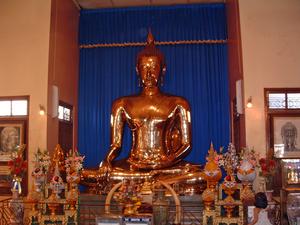
by Thomas Shepherd
In Thailand there are many, many Buddha’s. All over Asia, for that matter. There was one particular, Buddha which had sat outside the grounds of a Wat, or Temple. He was stucco, about 15 feet tall. Buddha sitting in the lotus position, eyes open, with a little half-smile on his face. Nobody knew how long this stucco statue had sat there in the courtyard outside the Temple. Just like the presence of the divine in the midst of life, the Buddha withstood Thailand’s political and social changes just like it weathered monsoon rains for generation after generation. In modern times, tourists posed beside the sacred image. Sometimes they put their hats on his head, or threw an arm around the sacred figure, like he was a Buddha buddy—a dangerous action, which can get you arrested in some countries. Kids left candy wrappers in his lap. Sometimes people brought flower and fruit offerings to the Buddha. Sometimes people paused to meditate before the image of Gautama Siddartha, the Enlightened One. And the Buddha kept smiling, as though guarding some secret. The Divine Presence, right in the midst of life.
Some of our conservative Christian friends might see the stucco Buddha as a heathen idol. But they, too, have no poetry in their souls.
The city fathers of Bangkok decided to build a highway right through the courtyard where the Buddha sat, so he got an eviction notice. Well, actually, the government was very nice about it and offered to provide heavy-lift equipment to move the stucco Buddha indoors. This would be good for the statue, too, because inside the Wat the Buddha could be venerated by the monks and photographed by tourists in a more controlled way. After all, even though it was poorly constructed, the Buddha was centuries old and deserved to retire with dignity.
Isn’t that remarkably like the Christian faith today? To become a center of spiritual life again, Christianity has to get moving, to quit lurking in the courtyards of the past. John Shelby Spong is a former Episcopal Bishop whom many Unity people admire greatly. Myself included. Bishop Spong wrote a nice endorsement about my new book. I had it framed; it hangs in my office. Anyway, Jack Spong wrote a lot of books that Unity and other New Thought churches really love—Rescuing the Bible from Fundamentalism, The Hebrew Lord: A Bishop’s Search for the Authentic Jesus, and his most provocative title: Why Christianity Must Change or Die: A Bishop Speaks to Believers in Exile.
That’s my point. Just as the stucco Buddha had to move as times change, so does the Christian church in general and every church in particular. But amazing things happen when you take action in faith.
Now, here’s the rest of the story about the stucco Buddha. A group of monks from the monastery had to relocate the clay Buddha from outside their temple to a new location. “The monastery was to be relocated to make room for the development of a highway through Bangkok. When the crane began to lift the giant idol the weight of it was so tremendous that it began to crack. What is more, rain began to fall. The head monk, who was concerned about damage to the sacred Buddha, decided to lower the statue back to the ground and cover it with a large canvas trap to protect it from rain. We pick up the official record of what happened next:
“Later that evening the head monk went to check on the Buddha. He shined his flashlight under the trap to see if the Buddha was staying dry. As the light reached the crack, he noticed a little gleam shining back and felt it strange. As he took a closer look at this gleam of light, he wondered if there might be something underneath the clay. He went to fetch chisel and hammer from the monastery and began to chip away at the clay. As he knocked off shards of clay the little gleam grew brighter and bigger. Many hours of labor went by before the monk stood face to face with the extraordinary solid gold Buddha.”
A solid gold Buddha. Fifteen feet tall. Weighing 5.5 tons!
“Historians believe that several hundred years before the head monk's discovery, the Burmese army was about to invade Thailand ( called Siam). The Thai (Siamese) monks, realizing that their country would soon be attacked, covered the precious golden Buddha with an outer covering of clay in order to keep their treasure from being looted by the Burmese. Unfortunately it appears that the Burmese slaughtered all the Thai (Siamese) monks and the well kept secret of golden Buddha remained until that fateful day (in 1957).”[1]
Today it sits in Wat Trimitr (Temple of The Solid Gold Buddha). The Gold Buddha, which is the most valuable sacred object (and largest gold statue of Buddha) in the world, dates back to the 15th century. It weighs approximately 5.5 tons and stands 15 feet high. It was encased in stucco in the 18th century to prevent its plunder by the invading Burmese army. When Bangkok was built, the statue was moved there and left outside a deserted temple.
Now…the question I ask is this: How many people do you pass on the street every day who are, in reality, solid Gold Buddha’s in disguise? And the answer is—class?—EVERYONE!
[1] http://www.ppsnabha.net/tour-3.htm